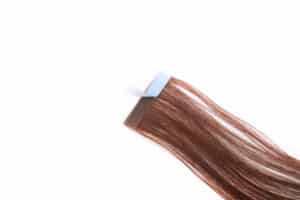Our website is supported by our users. This site contains affiliate links. If you click such a link and make a purchase, we may earn a commission for our endorsement, recommendation, testimonial, and/or link to any products or services from this website. Contact us for Questions

Is My Hair Too Thin for Extensions?
Thinking about getting hair extensions, but are wondering, is my hair too thin for extensions?
If you have thin hair, you may wish to thicken it. But, extensions have a reputation for causing damage if installed improperly.
Luckily there are good options out there if you have thin hair. In fact, extensions for thin hair can boost your confidence and help you attain your desired appearance.
Below, we’ll answer the question, “is my hair too thin for extensions” and share the best and worst types of extensions for thin hair.
Is My Hair Too Thin For Extensions?
There are numerous types of hair extensions, some of which are more damaging than others.
Thin hair is already delicate. So, choosing extensions that will not cause additional stress to the hair shaft or follicle is essential.
We will go over the best options for you, which include the following:
- Hand-Tied Weft
- Tape-in
- Halo
And the worst options for you:
- Clip-in
- Microlink
- Machine Weft
Best Hair Extensions For Thin Hair
Hand-Tied Weft Hair Extensions
Hand-tied weft extensions are hair extensions that have been sewn together. This method does not require much hair, resulting in a thinner lining and a more natural appearance against the head. Typically, they are used for beaded weft attachments.
Because they are non-damaging, hand-tied extensions are great for thin hair. Sew-in extensions are used instead of tapes, glue, or high temperatures, which might damage natural hair. Hand-tied wefts are tailored to your specific needs and are 60% thinner than machine wefts, making them ideal for thin hair.
With hand-tied hair extensions, a stylist first slides small silicone beads onto rows of hair. Then they hand-tie wefts of hair extensions through the beads using cotton or nylon thread.
Due to their delicate nature, they cannot be cut, but they are the best option for adding natural volume to thin, fine hair. This is due to their thin design, which allows them to lie flat without adding bulk or weight to the hair.
Tape-in Hair Extensions
Because each weft is lightweight, tape-in hair extensions are also a great option for thin hair. Typically, tape-in extensions are applied by sandwiching two extensions over a part of the hair. Using single-sided tape-in extensions may be a good idea if you have thin hair. Doing so will make your hair feel lighter.
The application of tape-in extensions does not require heat or any additional product. They are also ideal for individuals with short hair who wish to blend their extensions seamlessly.
Not only are they easy to install, but they can also be worn for extended periods, making them one of the most popular options for hair extensions.
Since they are lightweight and concealable, they are also suitable for those with fine, thin hair.
We still advise you to exercise caution, however. The adhesive from the tape can cause damage to your natural hair if it is not attached or appropriately removed, which is not ideal for women with thin hair.
With proper care and maintenance, tape-in extensions add volume and thickness to thin hair. They can also last up to eight weeks before needing to be reapplied. They can be applied three to four times in total.
Halo Hair Extensions
Halo hair extensions for thin hair are among the simplest to install. A hairstylist is not required to install halo hair extensions because installation is quick and easy.
With this option, you select your hair extension’s color, style, and length, and it arrives as a single piece attached to a clear wire. The hair extension is then worn as a headband. Using natural hair, you can conceal the wire on top of your head. Your thin hair will appear longer and fuller in minutes without causing any damage to your hair.
Hair Extensions To Avoid For Thin Hair
Clip-in Hair Extensions
Clip-in hair extensions are attached by clipping them to the scalp. As they can be installed in a matter of minutes and are removed at the end of the day, they are typically worn for special events or occasions.
While they offer convenience, those with fine, thin hair should avoid them. This is due to the weight of the clips, which could cause them to slide off of thin or fine hair. In addition, clips are typically more visible, so it will be obvious that you are wearing extensions.
Microlink Hair Extensions
Microlink hair extensions are small hair extensions. They do this using small metal tubes. They are the most natural-looking alternative, but this method may not suit thin hair.
They pull and strain during application, and removal can cause damage. Additionally, these extensions add considerable weight to the hair.
Machine Weft Hair Extensions
Machine weft hair extensions are sewn onto a weft by a machine. They can be installed with clips or glue or sewn onto the client’s head.
However, they are thick, bulky, and heavier than other extensions. And they are not suitable for those with fine, thin hair. They are more suitable for those with thick, coarse hair.







